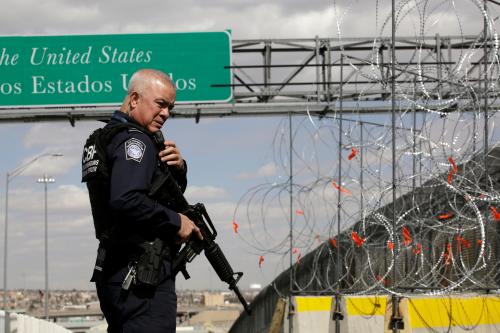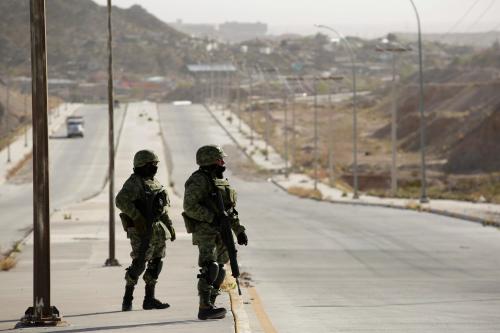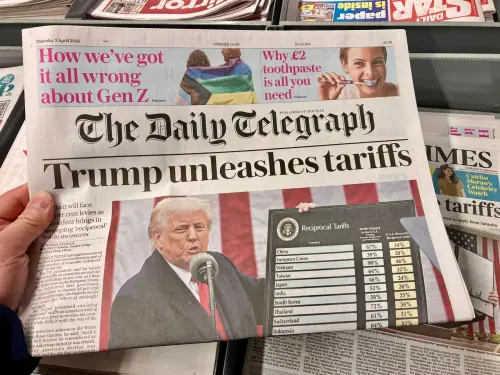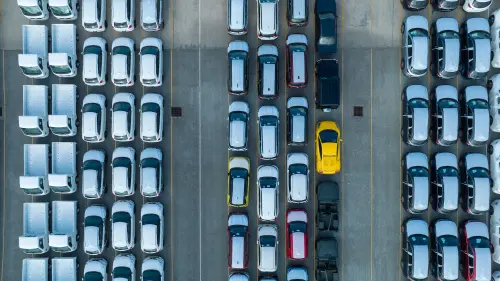The United States and Mexico urgently need to revitalize their partnership against cross-border crime, these authors argue, but President Trump’s threats to impose additional taxes on Mexican imports is the wrong way to do it. This piece was originally published by The Dallas Morning News.
What if Mexico threatened a 25 percent tariff on American corn and soybeans unless the U.S. stops providing an estimated $19 billion to $29 billion in yearly drug profits to Mexican criminal groups and blocks weapons trafficking to Mexico?
Mexicans can make a strong case that the illicit money, drug demand, and guns feed the violence and corruption plaguing their country. However, that would not be a constructive way to tackle shared problems.
Similarly counterproductive is the U.S. threat to put a 25 percent tax on Mexican car imports to the U.S., as President Donald Trump said, “if the drugs don’t stop or largely stop.” Those “Mexican cars” have on average 38 percent U.S. content. How many U.S. jobs would be hurt or lost?
But no doubt the United States and Mexico urgently need to revitalize their partnership against cross-border crime. This illegal commerce harms and kills far too many people on both sides of the border.
A task force of Mexican and American scholars and former officials prepared 13 key recommendations to take this vital work forward. The U.S.-Mexico Security Cooperation Taskforce, in which we participated, reviewed the last 10 years of bilateral cooperation and suggested priority steps to enhance progress against criminal operations. Going it alone is counterproductive.
U.S.-Mexico cooperation cannot solve drug demand in the U.S., nor can it solve the crime and violence in Mexico. Each government needs to manage its own challenges. However, better bilateral cooperation can strongly augment the capabilities of both. This requires swiftly forging a common action plan while working hard to build mutual understanding and trust.
Key steps include creating a senior-level coordination group, collaboration at federal and state levels, and strengthening joint criminal investigations. Building international liaison units and creating a U.S.-Mexico task force against fentanyl are equally vital. Both countries will benefit from community policing collaboration; enhancing cooperation on Central American criminal groups; avoiding clashes over marijuana policy; instituting better vetting against corruption; assuring frank dialogue on human rights; and strengthening collaboration against weapons trafficking and money laundering.
A Cabinet-level led coordination group would help reconcile the divergent public security priorities of the two governments and set out an agreed action agenda. The senior level group would then carry out the vital task of monitoring and reviewing progress, addressing problems that arise, and reporting to the two presidents.
A top priority for Trump is reducing the flow of opioids and other deadly drugs from Mexico. For President Andrés Manuel López Obrador, it is reducing the plague of violent homicides in Mexico. Though distinct, these priorities overlap: Mexican drug dealers do not stand at the border and slingshot the drugs into Chicago and New York. There are cooperating criminal networks distributing the drugs within the United States. And, the drug profits made in U.S. fuel violence and corruption in Mexico.
The United States and Mexico can agree to jointly prioritize drug-trafficking groups that smuggle fentanyl and other opioids to the United States. They can effectively target such groups not merely by going after the kingpins, but rather by rounding up as much of their network of both sides of the border in large operations built on good intelligence and joint prosecution. While these operations take time to develop and require patience and trust by U.S. and Mexican joint task forces, they can significantly weaken the operational capacity of criminal groups.
Without a common agenda for joint action and mutual assistance, cooperation becomes scattershot, episodic, ineffective and subject to periodic blowups. With an agreed bilateral strategy and action agenda, a well-functioning Cabinet-level group has a much better chance of overseeing progress toward each country’s public security priorities.
Strengthening Mexico’s federal and state law enforcement and justice forces also deepens the bilateral partnership. Mexico is building a new National Guard to help restore order. That force can benefit from U.S. training and technical assistance, through the joint Merida program, the umbrella for U.S. capacity building assistance in Mexico since 2008. Mexico’s border services would also benefit from Merida-funded state-of-the-art sensors to find contraband working with U.S. counterparts at the border.
Despite many hurdles, the U.S. and Mexico have forged binational teams that cooperated well over the past decade. That experience needs to be deepened, widened and better targeted, starting now.
The Brookings Institution is committed to quality, independence, and impact.
We are supported by a diverse array of funders. In line with our values and policies, each Brookings publication represents the sole views of its author(s).








Commentary
Tariffs won’t solve U.S.-Mexico drug crime
We must work together
April 29, 2019